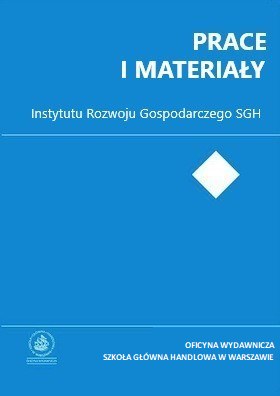Latent factor growth models for forecasting Polish GDP growth, inflation and unemployment using survey data
##plugins.themes.bootstrap3.article.main##
Abstrakt
In this paper a novel application of latent factor growth models is applied to responses to the manufacturing industry tendency survey conducted by the Research Institute for Economic Development, Warsaw School of Economics. An approach based on a common factor was assumed to explain variation in time response to specific questions drawn from the survey questionnaire. It was demonstrated that responses to questions relating to general economic situation in Poland, inflation and employment were explained by a latent growth factor, which was confirmed by RMSEA. Using cross-correlation and an ARIMAX model, it was shown that slopes obtained from latent factor growth models could be applied to forecasting or at least nowcasting of GDP growth and unemployment rate. Survey data of the type described clearly offer potential for refinement of economic projections and it is hoped that this work might stimulate further discussion of the methodology based on latent factor growth modeling for forecasting main macroeconomic time series.(original abstract)
##plugins.themes.bootstrap3.article.details##
Bibliografia
Adamowicz, E. (2013). Badania koniunktury. Fakty. Użyteczność, Warszawa: Oficyna Wydawnicza SGH.
Ang, A., Bekaert, G., Wei, M. (2007). Do macro variables, asset markets, or surveys forecast inflation better?, Journal of Monetary Economics, 54 (4), 1163-1212.
Bańbura, M., Giannone, D., Reichlin, L. (2010). Nowcasting (No. 1275).
Baranowski, P., Leszczyńska, A., Szafrański, G. (2010). Krótkookresowe prognozowanie inflacji z użyciem modeli czynnikowych, Bank i Kredyt, 41 (4), 23-44.
Białowolski, P., Dudek, S. (2008). Wzorce formułowania ocen i prognoz przez polskie gospodarstwa domowe – fakty i mity, Prace i Materiały Instytutu Rozwoju Gospodarczego SGH, 80, 43-61.
Białowolski, P. (2015). The influence of negative response style on survey-based, Quality & Quantity, doi:10.1007/s11135-015-0161-9.
Białowolski, P., Drozdowicz-Bieć, M., Łada, K., Pater, R., Zwiernik, P., Żochowski, D. (2007). Forecasting with composite coincident and leading indexes and the CLIMA model. The case of Poland, Warszawa: Oficyna Wydawnicza Szkoły Głównej Handlowej.
Białowolski, P., Kuszewski, T., Witkowski, B. (2014a). Bayesian averaging of classical estimates in forecasting macroeconomic indicators with application of business survey data, Empirica, 41 (1), 53-68.
Białowolski, P., Kuszewski, T., Witkowski, B. (2014b). Dynamic factor models & Bayesian averaging of classical estimates in forecasting macroeconomic indicators with application of survey data, National Bank of Poland Working Paper, 191.
Białowolski, P., Zwiernik, P., Żochowski, D. (2011). Modelling inflation using Markov switching models: the case of Poland (1992-2005), Prace i Materiały Instytutu Rozwoju Gospodarczego SGH, 86, 185-199.
Boivin, J., Ng, S. (2006). Are more data always better for factor analysis?, Journal of Econometrics, 132 (1), 169-194.
Bovi, M. (2009). Economic versus psychological forecasting. Evidence from consumer confidence surveys, Journal of Economic Psychology, 30 (4), 563-574.
Brown, T. A. (2006). Confirmatory factor analysis for applied research, New York, NY: The Guilford Press.
Browne, M. W., Cudeck, R. (1993). Alternative ways of assessing model fit, in Testing structural equation models, Newsbury Park, CA: Sage, 136-162.
Chan, D. (1998). The conceptualization and analysis of change over time: An integrative approach incorporating longitudinal mean and covariance structures analysis (LMACS) and multiple indicator latent growth modeling (MLGM), Organizational Research Methods, 1 (4), 421-483.
Chou, C.-P., Bentler, P. M. (1995). Estimates and test in structural equation modelling, in R. H. Hoyle (ed.), Structural equation modelling: Concepts, issues and applications, Thousand Oaks, CA: SAGE Publications, 37-55.
Clements, M. P., Hendry, D. F. (1998). Forecasting economic time series, Cambridge (UK): Cambridge University Press.
Darne, O. (2008). Using business survey in industrial and services sector to nowcast GDP growth: The French case, Economic Bulletin, 3 (32), 1-8.
Davidov, E. (2008). A cross-country and cross-time comparison of the human values measurements with the second round of the European Social Survey, Survey Research Methods, 2 (1), 33-46.
Drozdowicz-Bieć, M. (2012). Cykle i wskaźniki koniunktury, Warszawa: Poltext sp. z o.o.
Dudek, S., Walczyk, K. (2004). Business climate indicators to predict economic activity, Prace i Materiały Instytutu Rozwoju Gospodarczego SGH, 74, 283-298.
European Commission (2006). The joint harmonised EU programme of business and consumer surveys, European Economy, Special Report no. 5.
Frale, C., Marcellino, M., Mazzi, G. L., Proietti, T. (2010). Survey data as coincident or leading indicators, Journal of Forecasting, 29, 1, 109-131.
Greene, W. H. (2003). Econometric analysis, Prentice Hall.
Hansson, J., Jansson, P., Löf, M. (2005). Business survey data: Do they help in forecasting GDP growth?, International Journal of Forecasting, 21 (2), 377-389.
Henry, Ó. T., Shields, K. (2004). Is there a unit root in inflation?, Journal of Macroeconomics, 26 (3), 481-500.
Hu, L., Bentler, P. M. (1999). Cutoff criteria for fit indexes in covariance structure analysis: Conventional criteria versus new alternatives, Structural Equation Modeling, 6 (1), 1-55.
Kaplan, D. (2009). Structural equation modeling. Fundation and extentions, Los Angeles: SAGE Publications.
Kaufmann, D., Scheufele, R. (2013). Business tendency surveys and macroeconomic fluctuations, KOF Working Paper, 378.
Marsh, H. W. (2004). In search of golden rules: Comment on hypothesis-testing approaches to setting cutoff values for fit indexes and dangers in overgeneralizing Hu and Bentler’s (1999) findings, Structural Equation Modeling, 11 (3), 320-341.
Mueller, E. (1963). Ten years of consumer attitude surveys: Their forecasting record, Journal of the American Statistical Association, 58 (304), 899-917.
Reijer, A. H. J. (2012). Forecasting Dutch GDP and inflation using alternative factor model specifications based on large and small datasets, Empirical Economics, 44 (2), 435-453.
Rünstler, G., Sédillot, F. (2003). Short-term estimates of GDP by means of monthly data, ECB Working Paper, 276.
Steenkamp, J. E. M., Baumgartner, H. (1998). Assessing measurement invariance in cross-national consumer research, The Journal of Consumer Research, 25 (1), 78-90.
Stock, J. H., Watson, M. W. (2002). Macroeconomic forecasting using diffusion indexes, Journal of Business & Economic Statistics, 20 (2), 147-162.
Welfe, A. (2003). Ekonometria, Warszawa: Polskie Wydawnictwo Ekonomiczne.
